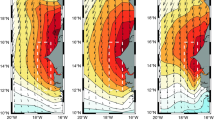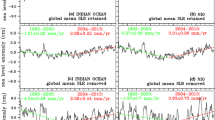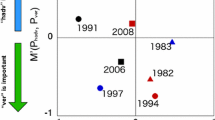Abstract
A general form of an equation that “explicitly” diagnoses SST change is derived. All other equations in wide use are its special case. Combining with the data from an ocean general circulation model (MOM2) with an integration of 10 years (1987–1996), the relative importances of various processes that determine seasonal variations of SST in the tropical Indian Ocean are compared mainly for January, April, July and October. The main results are as follows. (1) The net surface heat flux is the most important factor affecting SST over the Arabian Sea, the Bay of Bengal and the region south of the equator in January; in April, its influence covers almost the whole region studied; whereas in July and October, this term shows significance only in the regions south of 10°S and north of the equator, respectively. (2) The horizontal advection dominates in the East African-Arabian coast and the region around the equator in January and July; in October, the region is located south of 10°S. (3) The entrainment is significant only in a narrow band centered on 10° S in April and the coastal region around the Arabian Sea and the equator in July. (4) As for SST, it decreases in January and July but increases in April and October in the Arabian Sea and the Bay of Bengal, showing a (asymmetrical) semiannual variability; by contrast, the SST in the region south of the equator has an annual variability, decreasing in April and July and increasing in October and January.
Similar content being viewed by others
References
Behera, S. K., P. S. Salvekar, and T. Yamagata, 2000: Simulation of interannual SST variability in the tropical Indian Ocean.J. Climate,13, 3487–3499.
Carton, J. A., G. Chepurin, and X. Cao, 2000: A simple ocean data assimilation analysis of the global upper ocean 1950–95, Part II: Results.J. Phys. Oceanogr.,30, 311–326.
Chen, D., L. M. Rothstein, and A. J. Busalacchi, 1994: A hybrid vertical mixed-layer scheme and its application to tropical ocean models.J. Phys. Oceanogr.,24, 2156–2179.
Chen Lieting, 1991: Effect on zonal difference of sea surface temperature anomalies in the Arabian Sea and the South China Sea on summer rainfall over the Yangtze River.Scientia Atmospheric Sinica,15(1), 33–42. (in Chinese)
Feng, M., P. Hacker, and R. Lukas, 1998: Upper ocean heat and salt balances in response to a westerly wind burst in the western equatorial Pacific during TOGA COARE.J. Geophys. Res.,103, 10289–10311.
Ffield, A., and A. L. Gordon, 1992: Vertical mixing in the Indonesian thermocline.J. Phys. Oceanogr.,22, 184–195.
Godfrey, J. S., 1996: The effect of the Indonesian Through-flow on ocean circulation and heat exchange with the atmosphere: A review.J. Geophys. Res.,101(C5), 12217–12237.
Godfrey, J. S., and A. Schiller, 1997: Tests of mixed-layer schemes and surface boundary conditions in an Ocean General Circulation Model, using the IMET data set. CSIRO Marine Laboratories Report, 321pp.
Hellerman, S., and M. Rosenstein, 1983: Normal monthly wind stress over the world ocean with error estimates.J. Phys. Oceanogr. 13, 1093–1104.
Hu Ruijin, 2003: Study on the heat budget and the meridional circulation of the tropical Indian Ocean. Ph. D. dissertation, Ocean University of China, 99pp. (in Chinese)
Legler, D. M., I. M. Navon, and J. J. O’Brien, 1989: Objective analysis of pseudostress over the Indian Ocean using a direct-minimization approach.Mon. Wea. Rev.,117, 709–720.
Levitus, S., R. Burgett, and T. P. Boyer, 1994: World Ocean Atlas 1994, Volume 3: Salinity.NOAA Atlas NESDIS 3, U.S. Department of Commerce, Washington D. C., 99pp.
Li Chongyin, and Mu Mingquan, 2001: The dipole in the equatorial Indian Ocean and its impacts on climate.Chinese J. Atmos. Sci.,25(4), 433–443. (in Chinese)
Liu Hailong, Zhang Xuehong, and Li Wei, 2001: The heat balance in the western equatorial Pacific warm pool during the westerly wind bursts: A case study.Adv. Atmos. Sci.,18(5), 882–896. (in Chinese)
Masumoto, Y., and T. Yamagata, 1996: Seasonal variations of the Indonesian Throughflow in a general circulation model.J. Geophys. Res.,101, 12287–12293.
McCreary, J. P., P. K. Kundu, and R. L. Molinari, 1993: A numerical investigation of dynamics, thermodynamics and mixed-layer processes in the Indian Ocean.Progress in Oceanography,31, 181–244.
McPhaden, M. J., 1982: Variability in the central Indian Ocean, II: Oceanic heat and turbulent energy balances.J. Mar. Res.,40, 403–419.
McPhaden, M. J., and S. P. Hayes, 1991: On the variability of winds, sea surface temperature, and surface layer heat content in the western equatorial Pacific.J. Geophys. Res.,96(suppl.), 3331–3342.
Murtugudde, R., and A. J. Busalacchi, 1999: Interannual variability of the dynamics and thermodynamics of the tropical Indian Ocean.J. Climate,12, 2300–2326.
Nicholls, N., 1985: Sea surface temperature and Australia winter rainfall.J. Climate,2, 965–973.
Pacanowski, R. C., 1995: MOM2 Documentation User’s Guide and Reference Manual, Version 1.0. GFDL Ocean Technical Rep. 3, 232pp.
Qiu, B., 2000: Interannual variability of the Kuroshio Extension system and its impact on the wintertime SST field.J. Phys. Oceanogr.,30, 1486–1502.
Qu, T., G. Meyers, and J. S. Godfrey, 1994: Ocean dynamics in the region between Australia and Indonesian and its influence on the variation of sea surface temperature in a global general circulation model.J. Geophys. Res.,99, 18433–18445.
Rao, R. R., and R. Sivakumar, 1999: On the possible mechanisms of the evolution of a mini-warm pool during the presummer monsoon season and the genesis of onset vortex in the southeastern Arabian Sea.Quart. J. Roy. Meteor. Soc.,125, 787–809.
Rao, R. R., and R. Sivakumar, 2000: Seasonal variability of near-surface thermal structure and heat budget of the mixed layer of the tropical Indian Ocean from a new global ocean temperature climatology.J. Geophys. Res.,105, 995–1015.
Saji, N. H., B. N. Goswami, P. N. Vinayachandran, and T. Yamagata, 1999: A dipole in the tropical Indian Ocean.Nature,401, 360–363.
Schiller, A., J. S. Godfrey, P. C. McIntosh, G. Meyers, and S. E. Wijffels, 1998: Seasonal near-surface dynamics and thermodynamics of the Indian Ocean and the Indonesian Throughflow in a global ocean general circulation model.J. Phys. Oceanogr.,28, 2288–2312.
Schott, F. A., and P. M. Jr. McCreary, 2001: The monsoon circulation of the Indian Ocean.Progress in Oceanography.,51, 1–123.
Shetye, S., 1986: A model study of the Arabian Sea temperature.J. Mar. Res.,44, 521–542.
Shukla, J., and D. A. Mooley, 1987: Empirical prediction of the summer monsoon rainfall over India.Mon. Wea. Rev.,115, 695–703.
Simonot, J. Y., and H. L. Letreut, 1986: A climatological field of mean optical properties of the world ocean.J. Geophys. Res.,91, 6642–6646.
Stevenson, J. W., and P. P. Niiler, 1983: Upper ocean heat budget during the Hawaii-to-Tahiti shuttle experiment.J. Phys. Oceanogr.,13, 1894–1907.
Stricherz, J., J. J. O’Brien, and D. Legler, 1992:Atlas of Florida State University Tropical Pacific Winds for TOGA 1966–1985. The Florida State University, 256pp.
Webster, P. J., A. M. Moore, J. P. Loschnigg, and R. R. Leben, 1999: Coupled ocean-atmosphere dynamics in the Indian Ocean during 1997–98.Nature,401, 356–359.
Wu Guoxiong, Liu Ping, Liu Yimin, and Li Jianping, 2000: Impacts of the sea surface temperature anomaly in the Indian Ocean on the subtropical anticyclone over the western Pacific—Two-stage thermal adaptation in the atmosphere.Acta Meteorologica Sinica,58(5), 513–522. (in Chinese)
Xiao Ziniu, and Yan Hengming, 2001: A numerical simulation of the Indian Ocean SSTA influence on the early summer precipitation of the Southern China during an El Nino year.Chinese J. Atmos. Sci.,25(2), 173–183. (in Chinese)
Author information
Authors and Affiliations
Corresponding author
Rights and permissions
About this article
Cite this article
Ruijin, H., Qinyu, L., Xiangfeng, M. et al. On the mechanism of the seasonal variability of SST in the tropical Indian Ocean. Adv. Atmos. Sci. 22, 451–462 (2005). https://doi.org/10.1007/BF02918758
Received:
Revised:
Issue Date:
DOI: https://doi.org/10.1007/BF02918758




